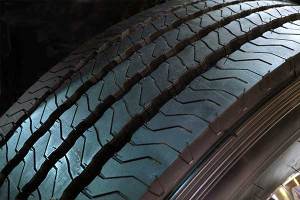
Why retread tires are popular
Did you know the production and use of retread tires saves the trucking industry more than $3 billion annually? As new tire prices continue to increase, fleet managers are searching for ways to reduce costs, while still operating safe and dependable vehicles. The use of recap tires is one solution fleets have found to combat this issue, and many are seeing benefits from utilizing them. Learn how retread tires are made, the benefits of using them and how to maintain them. We’ll also set straight some of the most common retreading myths you may have heard.
Retread process
Retreading was introduced in the early 1900s as a method to replace old, worn-out tread with new, reliable material. Today, there are more than 850 retread plants in North America that together produce millions of tires each year. While each plant may follow specific procedures or use specially designed machinery, the overall process is typically the same:
- Initial inspection
The first step is a visual inspection. A trained technician will examine the tire (internally and externally) for nails and holes using a shearography, X-ray or other non-destructive testing machine. If injuries are found, the technician marks the location and continues the inspection; or if the casing has too many problems it will be rejected. The primary purpose of this step is to make sure the tire is suitable for a second or third life.
- Buffing
Once the tire passes initial inspection, it’s sent to a buffing machine where all remaining tread is removed. The buffing prepares the casing’s surface for the application of new tread.
- Repairing
After buffing, the casing is inspected again, and any flaws or punctures are skived out and repaired. The tire is then wrapped in cushion-gum that aligns with the buffed surface. This step ensures the surface is smooth and ready to go.
- Application
The application step involves applying rubber to the buffed casing. There are two methods to retreading a tire: pre cure and mold cure — both of which require a certain amount of time, temperature and pressure. Here’s how each system works:
- Pre cure. Precurring means applying rubber to the casing that’s already vulcanized with the new tread design. The cushion gum (added during the repair stage) helps bond the pre cured tread to the tire. Once the tread is applied, the tire is placed into a rubber envelope and cooked in a curing chamber. The tread adheres securely to the casing during this time.
- Mold cure. This process involves applying non-vulcanized rubber to the buffed casing. The tire is placed into a rigid mold containing the new tread design and is then heated in the chamber. The heat molds and secures the tread design onto the tire.
- Final inspection
Before a tire is ready for the road, it must pass a rigorous inspection of the liner, beads, sidewall and tread in a high-pressure testing machine. If it passes, it’s painted, branded and imprinted with a Department of Transportation (DOT) number. This DOT number indicates the plant location and inspector’s name.
The benefits of retreaded tires
Purchasing tires is a fleet’s second highest expense after fuel. But using retreads can help save a significant amount of money. Other benefits include:
- Oil conservation. According to retread.org, “The manufacture of a new medium truck requires approximately 22 gallons of oil, but it only takes seven gallons to retread.” The use of less oil helps reduce America’s dependence on imported oil.
- Environmental friendliness. Did you know it takes a tire 50-80 years to naturally decompose? While the rubber is recycled in a variety of ways, it’s also reused in the retreading process. This process allows tires to be reused instead of piling up in landfills.
- Quality performance. Based on information from the Tire Retread & Repair Information Bureau, retreads are practical solutions that are just as reliable as new tires. As retread technology advances, fleets managers can feel confident about the quality and durability recaps offer.
Retread myths
Even though retreads are popular in the fleet industry today, there are still some commonly believed myths. Here are some of the most talked about:
Myth #1: Rubber found on the road is from retreads.
Tire debris on roadways comes from both new and retread tires and is typically caused by too much friction (which produces heat) on underinflated tires. No studies show that retreads shed a greater amount of tread.
Myth #2: They can’t handle high speeds.
Retreads and new tires are manufactured in the same manner. Because of this, retreads can be driven safely and comfortably at highway speeds just like new tires.
Myth #3: They aren’t safe.
Recaps are actually very safe. Along with commercial trucks, many other vehicles rely on the safety of retreads including U.S. Postal Service vehicles, commercial and military jets, taxis, ambulances and fire trucks.
Maintenance tips
Caring for retreads is no different than maintaining new tires. Use the following tips to keep recap tires in good condition:
- Clean them regularly to remove dirt and debris
- Check tread depth periodically
- Inflate to the correct PSI
- Practice good driving habits (avoid curbs, potholes and speeding)
- Start a preventive maintenance plan
Questions?
Retreads continue to gain popularity with fleet managers because of their many benefits. If you have any questions about how the process works or the advantages of using them, leave a comment below.
